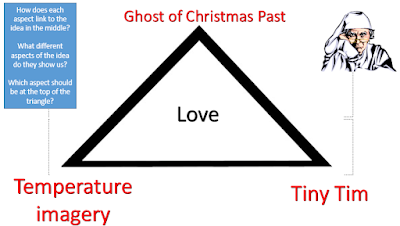Teaching a whole text can offer challenges to teachers. Some
students struggle with the immensity of the whole text. Often, a default method
for them is to revert to storytelling. Rather than search for choices made by
the writer in discussing an idea, they tell you the story and refer to examples
of the idea in the book. The best students writing about text are able to move swiftly
and effortlessly across several choices used across the text. They can go from
word analysis to characterisation to structure in one paragraph, while others
go through a clunky regurgitating of terms the teacher mentioned in lessons.
This term, with ‘A Christmas Carol’ and ‘An Inspector Calls’
I have been looking at how students can make connections across the texts, and
more importantly fuse the analysis of words, literary devices, structure and characterisation
together naturally. Of course, I could get students to look at each one
individually, but they need to do it naturally and automatically in their exam
and writing.
One question, we need to ask ourselves is: do the students
have enough knowledge of the choices the writer has relating to the words,
structure and characterisation?
How many choices do they know?
If they only know a limited number of choices made by the
writer, then they will either force their knowledge to fit the idea, or they
will revert to plot detail.
Also, a lot of teaching of texts involves teaching knowledge
relating to specific themes. We pick the key themes and teach the key choices
relating to those themes. Therefore, what is concrete in the brain are these
dominant themes and dominant choices, which are often shaped to fit another
theme, if the students hasn’t been explicitly been taught, in the exam.
Approach 1: Triangles
To deal with this aspect, I have created triangles.
Simply, I placed three things in the text together and students
had to relate them to the idea. At first, I focused with the emphasis on
characters. I placed two characters on the triangle and one point about
structure or a language device. Then, occasionally, I mixed this up.
The great thing I found about this was the creation of
interesting links and connections. I once placed the idea of ‘awe’ in the middle
and this produced some really interesting explorations of the texts such as
Tiny Tim is the epitome of awe, yet Scrooge is the antithesis, because nothing
creates that sense of awe in him.
For the literature exam, students don’t need an endless list
of techniques, but they do need to select and pick the appropriate pieces of
evidence to use and explore the connection between these bits of evidence.
Then, I’d get students to turn the triangle into a square, because
I love a cross-curricular link. Then, they see what they’ add as the next
point. Or, I get them to rearrange the points and decide on which goes at the
top as the most important or effective choice. If I wanted to be obtuse, I’d
throw in a random or obscure choice to get the little grey cells working.
Finally, I’d introduce an extract and get the students to
find evidence to support these ideas.
Approach 2: Lists
Another thing I did was list a large number of choices made
by the writer.
This was a simple thing to do. I gave students the question
and a list of choices. Some relevant and some not.
If we are going to get students better at analysing texts,
we need to give them endless knowledge of what sort of things they should be
talking about for. We need them to be knowledgeable about choices. As I do this, I will be removing the lists
later. But, they need an internalised list to help them plan an idea. That’s
what this method does. I am working on building their internalised list of
choices.
Rather than spend endless lessons on the six big themes of
the text, I am exploring forty or so themes / idea in the text with students.
Rather than have the same six techniques used for every essay, I am having
fifty or so different choices in responses.
We can’t rely on set essay plans to help students. This isn’t
‘Of Mice and Men’ any more. You no longer have six characters, six themes and
six key moments in the book. In fairness, ‘Of Mice and Men’ was so easy to
teach because of that aspect. It was even easier, when you looked at the
previous exam, because that reduced the teaching to five characters, five
themes and five key moments. Even less to plan and teach.
Thanks for reading,
Xris




This is so interesting. I particularly like the second idea. Can I ask what you asked students to do once they'd decided which choices best related to the question? I don't suppose you'd be able to share the list of choices made by Priestley that you came up with?
ReplyDelete